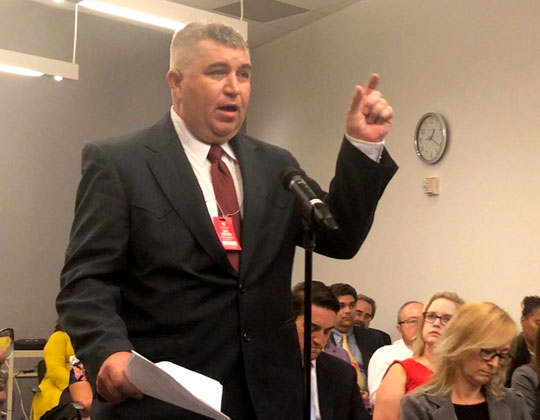OOIDA to FMCSA: Flexibility equals safety
The Owner-Operator Independent Drivers Association’s message to FMCSA was a simple one. If you want to improve highway safety, professional drivers need more control over when it is and when it isn’t safe to drive.
OOIDA Executive Vice President Lewie Pugh delivered that message during the agency’s public listening session regarding its proposal for hours-of-service reform on Tuesday, Sept. 17, in Washington, D.C.
“OOIDA fully supports the proposal because it allows drivers more opportunity to rest when they are tired, to stay off the road during adverse conditions, to avoid congestion, and to give drivers more control of their schedules, which will improve highway safety,” said Pugh, who was a truck driver for 22 years with more than 2 million safe miles.
On Aug. 22, FMCSA published a notice of proposed rulemaking in the Federal Register that included five main changes to the hours of service.
- The limits for short-haul operations would increase from 12 to 14 hours and from 100 air miles to 150.
- The adverse driving provision would allow a driver up to a 16-hour window within which to complete up to 13 hours of driving if the driver encounters adverse conditions.
- The 30-minute break requirement would be modified, prohibiting driving for more than eight consecutive hours without at least one 30-minute change in duty status. This would allow 30 minutes of on-duty, not driving time, off-duty time, or sleeper-berth time to qualify as a break.”
- In addition to splits of 10/0 and 8/2, drivers would be allowed a split-sleeper option of 7/3.
- Drivers would have the option of stopping the clock a minimum of 30 minutes and up to three hours consecutively once per duty period.
FMCSA announced Tuesday that the deadline to comment on the notice of proposed rulemaking has been extended until Oct. 21.
“The agency believes this extension will provide interested parties and the American people additional time to submit comments on this important proposal,” the agency said.
FMCSA said the goal of the proposal is to give drivers the flexibility they covet.
“We believe the proposals in this rule will improve safety by offering the flexibility drivers need so they do not feel like they are racing against the clock, needlessly driving through congestion, or hunting for parking,” FMCSA Deputy Administrator Alan Hanson said.
Pugh said the proposal should not only improve highway safety but also improve the health of individual drivers.
“Drivers need flexibility in the hours of service not only to make their deliveries and pickups, but to deal with many unforeseen obstacles that they deal with on a daily basis,” Pugh said. “These changes will also improve a driver’s health and well-being because it lessens the beat-the-clock mentality that seems to be shoved down on their shoulders now.”
The key to the plan, Pugh said, is to make sure that the decisions are truly in the drivers’ hands, and they are not being persuaded by motor carriers or others to work longer days than they should.

“For far too long a driver’s time has been worth nothing, especially to shippers and receivers and large motor carriers,” he said. “This needs to change. Being able to stop the clock for up to three hours, being able to expand the sleeper berth provision – this should all be a driver’s choice that he should be able to use when he deems necessary.
“I hope the agency will take the responsibility in preventing drivers from being coerced by carriers and shippers and receivers. Drivers for too long have been expendable commodities to a lot of people, including the government, and I hope that’s coming to a halt. Drivers are professionals, and they are not expendable by any means.”
OOIDA is also suggesting some tweaks to the proposal, including allowing split-sleepers of 5-and-5 and 6-and-4 and allowing drivers to take the 30-minute break in increments.
Pugh said the OOIDA Foundation is working to provide FMCSA with information on why additional split-sleeper options would be beneficial to drivers and highway safety.
The two-hour listening session gave truck drivers, motor carriers and trade associations the opportunity to comment and ask questions about the proposal.
Markcus Davis, an OOIDA member and preacher from South Carolina, told FMCSA leaders that the need for change became even more necessary when the electronic logging mandate went into effect in December 2017.
“Do you all know that drivers are driving tired more now than ever now since elogs have been instituted? Ask the truck drivers, they will tell you,” Davis said. “I’m not talking about a study. I’m talking about facts. I hear about all of your data and everything, but I’m coming from truth. Drivers are driving tired on these elogs more now than ever.”
In February 2018, OOIDA submitted a petition regarding hours-of-service reform to FMCSA as truck drivers were saying that the ELD mandate revealed the problems with the hours of service. In the petition, the Association asked for more control and flexibility for drivers.
FMCSA officials promised the agency’s proposal is intended to do just that.
The agency is accepting comments on the plan at the regulations.gov website by using docket number FMCSA-2018-0248.









